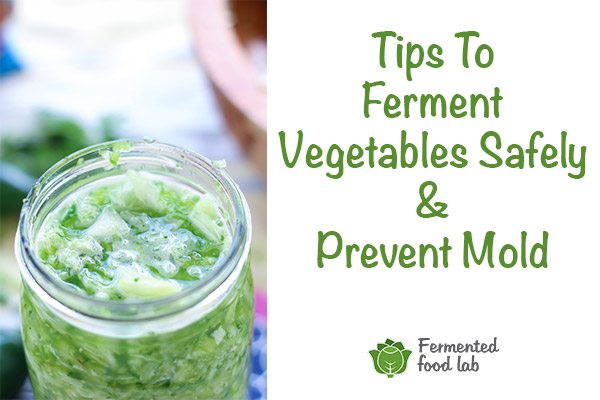I was raised NOT to leave food sitting on the counter. So you can imagine how horrified I was when I was following the Body Ecology Diet and came across the section on making fermented vegetables. Hell no… no way… no way…
I skipped that section and moved on.
But something happened…
You know when you buy a new car and suddenly you notice that car everywhere? Or when you learn a new word and suddenly everyone is saying it? Once I learned about fermented vegetables, I started to hear about them everywhere.
So finally, after more and more research and watching YouTube videos for days, I committed to adding them to my diet. It was the best thing I’ve done for my health!
I’ve learned some things, so here is my advice.
How do you ferment vegetables, sauerkraut, kimchi, pickles, etc without making you or your family sick?
To give you confidence about the whole process and ease your fears, it helps to understand the science behind it.
What is lacto-fermentation?
All the vegetable recipes on this blog use lacto-fermentation. The “lacto” stands for lactobacillus bacteria. Not to be confused with lactose. Lacto-fermentation doesn’t use dairy.
Lacto-fermentation is the oldest form of food preservation in the world. It involves only salt, water and vegetables. The salt water brine creates an anaerobic environment (free of oxygen) where only lactobacillus bacteria can survive. The lactobacillus bacteria act as a preservative, keeping harmful bacteria from living in the ferment.
The article, “Lacto-fermentation – How It Works” written by Food Preservation Expert, Leda Meredith explains the stages as…
In stage one of lacto-fermentation, vegetables are submerged in a brine that is salty enough to kill off harmful bacteria. The Lactobacillus good guys survive this stage and begin stage two.
In stage two of lacto-fermentation, the Lactobacillus organisms begin converting lactose and other sugars present in the food into lactic acid. This creates an acidic environment that safely preserves the vegetables – and gives lacto-fermented foods their classic tangy flavor.
The result is a food that is loaded with probiotics and flavor. Eating probiotic foods like this strengthens your immune system, increases vitamin and mineral absorption and helps balance hormones.
How safe is lacto-fermentation?
Lacto-fermentation is safe if you follow recipes that use the correct salt to water ratios for the brine. My recipes are all tried and true so you don’t have to worry about them. The brine creates an environment where harmful bacteria can’t survive making the food safe and healthy for eating.
You must let it ferment enough to allow the stages as described above to happen. You can tell a ferment is safe to eat if it smells sour and pleasant. If it smells rancid, like broccoli or lettuce rotting in your fridge, then something went wrong and it should be thrown out.
Tips for Safe Fermentation
Follow these tips and banish the fears that are preventing these healing foods from being in your life.
- Use fresh ingredients. Don’t use old, soggy cabbage or vegetables for your ferments. At this point they already started rotting on their own and could cause a ferment to go bad.
- Maintain good hygiene – Clean your vegetables. Wash your tools and hands with hot, soapy water before use.
- Use the exact amount of salt the recipe calls for. Some people are concerned about salt content, but it’s extremely important to create an environment that is inhospitable for harmful bacteria to survive. All my recipes are tested and use the right amount of salt for safe fermentation without being too salty.
- Salt distribution – Make sure salt is evenly distributed in the cabbage when making sauerkraut. When making pickles make sure salt is completely dissolved in the brine.
- Do not use iodized salt or table salt. Table salt has additives that can make the ferment go bad. I recommend fine high quality sea salt.
- Purified water – Make sure to always use either distilled or purified water when fermenting vegetables. Tap water contains chemicals like chlorine that harm good bacteria, which could lead to a bad ferment.
Quick Tips to Prevent Mold
Sometimes when you’re fermenting for a longer period of time (5+ days), mold can start to form on the surface of the brine. You can skim it off the top. Everything under the brine is still safe to eat.
If mold develops under the brine, the batch is bad. Throw it away.
Here are some ways to prevent mold from forming so you don’t have to deal with it.
- Stir the surface of the fermented vegetables daily to prevent mold from forming on the surface. Or push vegetables that are sticking up out of the brine back down. Sometimes I just close the lid tight and shake them up each day. It does the trick.
- Use a jar with an airlock lid. These lids are designed to prevent air from entering the jar and inhibiting mold. You can get them here.
- Use a fermentation crock with a water seal. These are the Cadillacs of the crocks and are designed to create an air tight seal, therefore preventing mold. They are also sold here.
Follow these tips and you won’t have to worry about making yourself or your family sick. In case you aren’t sure about a ferment you made, download my troubleshooting tips sheet at the end of this post or you can comment on this post or email me with your concern or question.
Happy & Safe Fermenting!
-Danielle

First timer at fermenting. The brine is really cloudy is that ok.
Yes. That’s exactly what it should look like :)
What is the water-salt proportion that you use in brine solution?